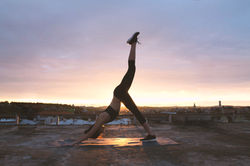FINAL REFLECTION
YOGA
"Awareness is the secret of yoga"
- Sancrit Proverb
WHY YOGA?
Therapeutic, Peaceful, Calm.
When I lived in London, I used to have yoga classes every week, for about 2 years. Initially, I thought it was more for older people, and I imagined it as a stereotypical 'OM' position.

However, after the first class, I left feeling lighter, calmer, and overall more positive. When moving to Dar, I did a few yoga sessions at Mukti, however, I did not keep this up, so I thought quarantine was a perfect time to restart, especially as a mental break from all the surreal things going on around me. I love yoga, it also challenges your flexibility, so it is a great way of maintaining a good physical shape. I recommend it to everyone!
COMPONENTS OF FITNESS
BENEFITS
Mental
-
Improved psychological/mental well being
-
concentration on the breath and body
-
-
Helps anxiety and depression
-
Lowers blood pressure and heart rate
-
-
Increased happiness
-
Releases dopamine, oxytocin and serotonin
-
-
Increases self-awareness
-
Decreases cortisol levels
-
-
Decreased stress levels
Physical
-
Improved flexibility
-
Yoga consists of many stretching exercises and poses that target flexibility. By stretching your muscles, one can notice improved flexibility soon after they start yoga exercises.
-
-
Improved strength
-
By building and toning muscles, gradual strength will build up. Poses can target upper body, lower body, and abdominal strength.
-
-
Improved balance
-
Single-legged poses and poses that target one's centre of gravity help develop balance, which also enhances posture.
-
 |  |  |  |
|---|---|---|---|
 |  |
MUSCLE GROUPS & MORE
Looking at the two most common, and simplistic yoga poses, and other common muscle groups used in yoga.

The downward dog is one of the most well-known yoga positions universally. It is also often used in warm-down activities after sports, and it targets the hamstrings and abdominals to loosen up after exerting lots of energy.
-
Elongates and releases tension from your spine
-
Opens the hips and shoulders
-
Stretches hamstrings, calves, arches, hands
-
Strengthens arms, shoulders, wrists, ankles, abdominals
Hamstrings
-
Helps to extend your hips high off the ground, supports the glutes. The higher you extend your glutes, the more the hamstrings are stretched.
Glutes
-
Tensing your glutes, and holding the downward dog for more than 30 seconds will build up the gluteus maximus.
Abdominals
-
Whilst the downward dog does not target extreme core strength, the abs will support the pose, and over time build abdominal strength.
Downward Dog

Cobra / Upwards Dog
The 'Cobra', or 'Upward Dog', presents the inverse to downward dog. It mainly focuses on the spine and is commonly used as a form of back pain relief and a full-body stretch.
-
Stretches muscles in the shoulders, chest and abdominals
-
Decreases stiffness of the lower back
-
Firms and tones the buttocks
-
improves circulation of blood and oxygen, especially throughout the spinal and pelvic regions
-
Strengthens the spine
Spinal Extensions
-
Stretches the entire spinal cord, up to the infraspinatus, commonly used by chiropractics.
Hamstrings
-
Hamstrings are stretched tighter the more one's legs touch the ground. It also stretches the carves.
Glutes
-
Tightening the gluteus maximus will help tone the buttocks and build strength.
Spinal Reflexes in Yoga
Different States in Yoga
-
State One – both the shortened and the stretched muscle group can be relaxed. This requires minimal physical effort.
-
State Two – the shortened muscle group can be tensed and the stretched muscle group can stay relaxed. This helps to strengthen the shortened muscle.
-
State Three – the stretched muscle group can be tensed and the shortened muscle group can remain relaxed. This helps to strengthen the stretched muscle in a lengthened position.
-
State Four – this is when both the shortened muscle group and the stretched muscle group are tensed. This stabilises the joint complex, helps to regulate circulation, and improves strength, flexibility, and the ability to relax all involved muscles.
-
The Myotatic Reflex – this is the stretch reflex. This reflex causes a lengthened muscle group to become tense if it is suddenly stretched, therefore, you need to block this reflex in yoga when trying to stretch. The reflex can be blocked by mentally focusing on the muscle group being stretched, exhaling as you move slowly into a stretch using the shortened muscles to actively move the joint complex into position.
-
The Reciprocal Relaxation Reflex – this reflex causes the stretched muscle group to relax when the shortened muscle group is tensed. It can be used to help you relax and stretch any part of your body.
-
The Inverse Myotatic (Relaxation) Reflex – this reflex causes the stretched muscle group to relax if it is stretched enough. It usually occurs after at least 12 to 15 seconds.
EQUIPMENT










Click on the image to learn more!
SOURCES
LINKS...
-
https://www.bigshakti.com/definitions-of-yoga/
-
https://www.yogiapproved.com/yoga/mental-benefits-of-yoga/
-
https://www.healthline.com/nutrition/13-benefits-of-yoga#section9
-
https://www.webmd.com/balance/guide/the-health-
-
https://www.yogajournal.com/lifestyle/plumb-perfectbenefits-of-yog
-
https://www.naturaltherapypages.co.uk/article/the_structure_of_yoga
-
https://arogyayogaschool.com/blog/10-health-benefits-of-cobra-pose-bhujangasana/
-
https://www.pinterest.co.uk/pin/464011567829209517/